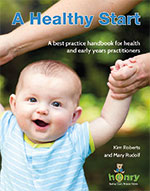
Download the PDF of Nutrition: By Choice
Eating is a deeply personal experience, and a complex one for early years practitioners when it comes to ensuring that young children eat well, enjoy food and have a healthy and nutritious diet.
Young children can be acutely sensitive and easily overwhelmed by the tastes, smells and textures of food. Each child is unique and brings to their setting tastes acquired from home and from their cultural and religious backgrounds. Some may have dietary requirements due to allergies or intolerances which, if overlooked, can have serious consequences.
By age three, children are also likely to be aware of adults’ expectations of what and how they should eat. This can be an unwelcome pressure that can take away the pleasure to be gained from eating.
RESPONSIBILITIES
Practitioners’ responsibilities extend beyond simply providing a balanced and nutritious diet for the children in their care. The EYFS states that children should know the importance of a healthy diet and that practitioners must help children to ‘make healthy choices in relation to food’. So, as well as informing children about healthy living, the expectation is that practitioners will help each child in their care to develop a healthy relationship with food.
These are responsibilities that need to be taken seriously as research suggests that the habits and tastes established in childhood have a life-long influence. Yet they are not as simple as they first appear. Many children express strong preferences for certain foods and yet there is compelling evidence that food preferences are learned rather than inborn.
From the start, children are surrounded with messages about food and eating. Sweets and cakes are often associated with pleasure and given on special occasions such as birthdays, or as rewards, so can become associated with pleasure, whereas fruit and vegetables may be labelled ‘good for you’ rather than pleasurable to eat. So how can practitioners help children make healthy choices in what they eat and develop a healthy relationship with food?
STRATEGIES TO SUPPORT HEALTHY CHOICES
Offer food, don’t impose it
However appetising it may appear to adults, food in settings will vary from that experienced by children in their homes in the way it is selected, cooked and presented. This can be challenging for children who may be used to a specific variety of food, cooked in a certain way. Pressure to eat or ‘try’ food may discourage children’s curiosity and inclination to explore new experiences.
Maintain a relaxed approach
Children’s bodies belong to them and it is important that they know this at an early age. Adults make the decisions regarding which foods are available to children, but respecting children’s choices about what they put in their mouths can help to reduce tensions regarding eating.
Optimise choice
While it is neither practical nor desirable to provide a limitless menu, enabling children to make choices about food can help them develop a sense of independence and think about what they enjoy eating, thereby make eating more satisfying. Offering small bowls of unfamiliar foods offers a gentle way extending children’s food repertoires without obligation.
Allow time
An environment that enables children to eat at their own individual paces recognises the importance that eating plays in children’s well-being and affords them the opportunity to engage with their own eating experience in a relaxed and unhurried way.
Allowing children plenty of time to experience mealtimes enables them to listen to their bodies, so they become more aware of when they are hungry or thirsty. This helps develop self-regulation, to know when they are full and have eaten enough.
Share food
Eating with children is a great way to reinforce messages about food and eating. Practitioners can model healthy eating and express pleasure in eating healthy food, which can help raise children’s awareness of pleasant physical sensations related to eating.
Talking with children about food and listening and responding to their ideas informs practitioners about children’s concepts about food and eating. It can also enable practitioners to observe children’s eating habits closely and make more finely-grained judgements on how to support them.
Encourage participation
Looking for opportunities to optimise children’s involvement – such as laying the table, pouring drinks, serving food to others or peeling their own bananas – fosters feelings of competence and satisfaction for children and can help form positive associations with mealtimes.
Practitioners at an innovative nursery in Germany, Dolli Einstein Haus, allow children to plan their own weekly menus, which are then voted on by the children.
Give gentle praise
Acknowledging children’s willingness to explore new foods encourages them to try new experiences without pressure. In one case study (see box), the practitioner indicates her pleasure to Jack, a reluctant eater, when he tries some grated carrot.
While she makes Jack aware that she is pleased with him, she does this without a fuss in front of others. This maintains Jack’s feelings of control and autonomy and may encourage him to try other new taste sensations.
Plan food-related activities
Activities outside of mealtimes such as children growing and cooking their own food can help develop positive attitudes towards mealtimes. Settings’ policies can be enhanced by taking into account the physical, social, emotional and cognitive aspects of food and looking for opportunities that support children’s feelings of independence, competence and pleasure regarding eating and food.
CASE STUDIES
Carrots and beetroot
Practitioner Laura helps children select their food at lunch then joins them at the table to eat her own. She brings with her some extra food – small bowls of carrots and beetroot – and is keen that three-year-old Jack tries them as he always chooses white bread, grated cheese and lots of mayonnaise. ‘Today, I’ve chosen some beetroot and grated carrot for everyone,’ she says. ‘Who would like to serve them?’
Jimmy and Anya are chosen and walk around the table inviting the others to help themselves. Jack watches but declines the invitation. ‘I love eating my carrots and beetroot,’ says Laura. ‘I like the colours.’ This leads to the children talking excitedly about the food and how carrots help them to see in the dark. Jack watches and listens and a few weeks later takes some grated carrot. Laura smiles at him.
Stewed apples and custard
Four-year-olds Kira and Rahul sit at the table with five other children. On the table are placemats made by the children, a bowl of stewed fruit and a jug of custard. Kira pours custard onto her fruit. ‘Look how I can do it,’ she says. She then chops up the mixture with her spoon, takes a spoonful and blows on it.
Rahul: ‘Mine isn’t hot.’
Kira: ‘It’s warming my tummy up. I can actually feel it. Is it warming your tummy up?’
Rahul: ‘Mmmmm. Mmmm.’
When she has finished, Kira takes her bowl and cup to the washing-up table.
Nicola Watson is a senior lecturer in early childhood at the University of Worcester.
MORE INFORMATION
Albon D and Mukherji P (2008) Food and Health in Early Childhood. Sage
Children’s Food Trust (2016) Voluntary Food And Drink Guidelines For Early Years Settings In England – A Practical Guide, www.childrensfoodtrust.org.uk/blog/resources/ey-guidelines
Wilson B (2015) First Bite: How We Learn to Eat. Fourth Estate
A HEALTHY START

The latest research and years of experience of working with families inform the strategies set out in this new guide to promoting child health and well-being
A Healthy Start: A best practice handbook for health and early years practitioners provides invaluable advice on how settings can work with families to lay the foundations for a child’s long-term physical and emotional well-being.
Publisher of the handbook is award-winning charity HENRY (Health, Exercise and Nutrition for the Really Young). Over the past decade, it has shown that confident and skilled practitioners can move beyond simply providing parents with information, and can instead work in partnership with them to bring about real and lasting change.
Authors Kim Roberts, HENRY chief executive, and Mary Rudolf, a consultant paediatrician and professor of child health, have drawn on this decade of experience and the latest research to provide information and advice in five main areas:
- The importance of the early years to lifelong health and well-being.
- How to support changes in behaviour.
- Pregnancy through to introducing solids.
- How family lifestyles and parenting can ensure a child’s physical and emotional well-being.
- Childhood obesity and early intervention.

Within these categories, the handbook addresses a wide variety of subjects, including sleep, oral health, infant feeding, healthy food swaps, the parent-child relationship and how to create the conditions for change.
HENRY provides a range of holistic programmes to prevent and manage early childhood obesity, and this handbook reflects the extent to which the charity has broadened the scope of its work to include a greater focus on children’s wider social and emotional development and well-being.
A Healthy Start: A best practice handbook for health and early years practitioners by Kim Roberts and Mary Rudolf, priced £20, is available at: www.henry.org.uk









